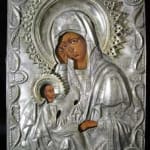The Mother of God Soothe My Sorrow, 19th Century CE
Oklad/Paint on Wood
11.5
PF.5699
Further images
Inseparable from the liturgical tradition, religious art functions as a form of pictorial confession of faith and a channel of religious experience for Orthodox Christians. Because icons were believed to...
Inseparable from the liturgical tradition, religious art functions as a form of pictorial confession of faith and a channel of religious experience for Orthodox Christians. Because icons were believed to provide direct personal contact with the holy persons represented on them, these images were objects of veneration, in either a public or private setting or during travels, and were also thought to have the ability to heal.
The painting style of this icon is derived from earlier Byzantine paintings and mosaics. This influence is evident in the elongated facial structure of the Virgin. Hard lines define her features. Sinuous arches form her brown and flow into her thin, rigid nose. Her eyes are perfect ovals. Her image is not based in naturalistic reality but is the portrait of divinity. Forms are purposefully manipulated to appear unusual and expressive. The majority of the composition has been covered by silver washed oklad. A repoussé technique in high relief has been utilized to produce the folds and curves of the robes, as well as the effect of the bodies’ mass beneath. A decorative floral motif has been inscribed along the edges of Mary’s robes. The borders of the icon have been adorned by a series of winding leaves emerging from oyster shells that mark the corners, all depicted in a medium relief. Halos have been attached over the heads of the holy figures; the edges of the Virgin’s are perforated. Above all, this scene is an intimate moment between mother and child.
The painting style of this icon is derived from earlier Byzantine paintings and mosaics. This influence is evident in the elongated facial structure of the Virgin. Hard lines define her features. Sinuous arches form her brown and flow into her thin, rigid nose. Her eyes are perfect ovals. Her image is not based in naturalistic reality but is the portrait of divinity. Forms are purposefully manipulated to appear unusual and expressive. The majority of the composition has been covered by silver washed oklad. A repoussé technique in high relief has been utilized to produce the folds and curves of the robes, as well as the effect of the bodies’ mass beneath. A decorative floral motif has been inscribed along the edges of Mary’s robes. The borders of the icon have been adorned by a series of winding leaves emerging from oyster shells that mark the corners, all depicted in a medium relief. Halos have been attached over the heads of the holy figures; the edges of the Virgin’s are perforated. Above all, this scene is an intimate moment between mother and child.







